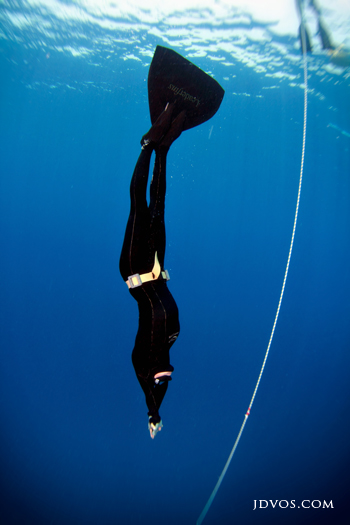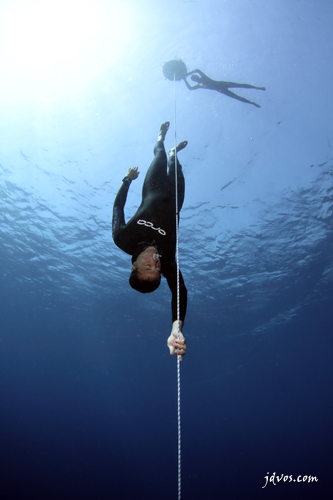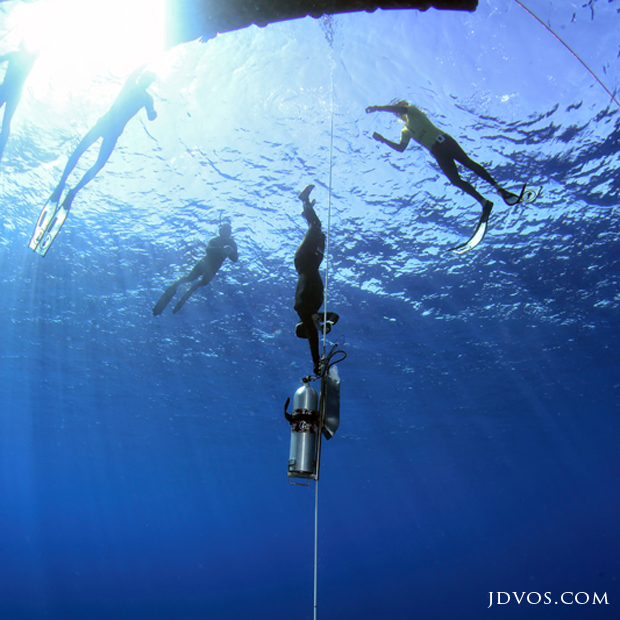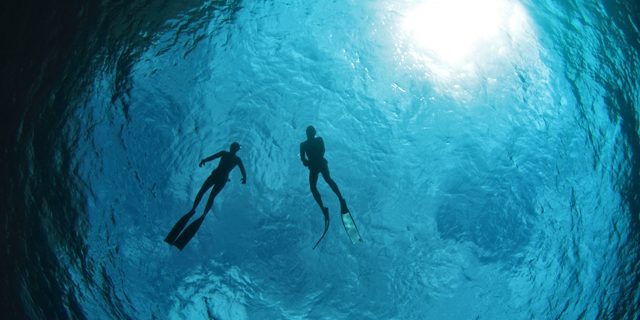By Benajmin Boehme
This is article is directed to beginners or non-freedivers as an overview of the different freediving disciplines. We will go through each one of them and explain their benefits and difficulties.
In freediving there are six competition disciplines and two non-competition disciplines which sums up to a total of eight. This at least are the recognized AIDA disciplines. There are endless other disciplines like dynamic under ice where the freediver tries to cover the longest distance while diving under ice. Submerging in one hole and coming back out at another one. People keep being inventive and create more and more disciplines like tandem no limit diving etc.
We will focus on the official disciplines and start with the depth disciplines and leave the pool disciplines for the next post.
Constant Weight with Fins (CWT)
 This is the discipline with the deepest records in the competitive disciplines. Constant Weight means that the freediver has to descent and ascent with the same amount of weight. It wouldn’t be constant weight, if you have 3 kilogram on your weight belt to make your descent easier and then you drop it at the bottom for an easier ascent.The world record in Constant Weight with Fins or often just called Constant Weight is at 128 meters by Alexey Molchanov set at the World Championships 2013 in Kalamata in Greece and 102 meters by Natalia Molchanova (his mum) for the women. The Constant Weight records are usually set with a monofin since it is more efficient than bi fins.
This is the discipline with the deepest records in the competitive disciplines. Constant Weight means that the freediver has to descent and ascent with the same amount of weight. It wouldn’t be constant weight, if you have 3 kilogram on your weight belt to make your descent easier and then you drop it at the bottom for an easier ascent.The world record in Constant Weight with Fins or often just called Constant Weight is at 128 meters by Alexey Molchanov set at the World Championships 2013 in Kalamata in Greece and 102 meters by Natalia Molchanova (his mum) for the women. The Constant Weight records are usually set with a monofin since it is more efficient than bi fins.
Photo of Linda Paganelli during a constant weight dive, shot by Jacques De Vos
Sara Campbell did a dive to 104 meters outside the Blue Hole in Dahab which is deeper than the World Record but if you don’t do the dive in a recognized competition it is still awesome but not validated as a world record.
Have a look at the link to see her beautiful and impressive dive shot by Jacques De Vos
Some organizations also have records in Constant Weight with Bi-Fins. William Winram set on at 94 meters in 2013 at the Carribean Cup. So you see a difference of 34 meters between bi fins and monofin if you compare the world records.
Free Immersion (FIM)
is similar to constant weight with fins as the amount of weight during the dive has to stay the same as well. This actually counts for all three different depth disciplines.

The specialty about Free Immersion is that the freediver descents and ascents by pulling on the rope without wearing fins. The discipline is considered very relaxing as there are not many movements involved and the technique is fairly easy to learn, which makes it the ideal discipline to practice equalization as you don’t have to focus on a difficult technique like in constant weight no fins and you can go down as slowly as you want. The one thing that can be a bit tricky in the beginning though is the freefall without fins. The current world record in freediving is set by William Trubridge at a depth of 121 meters. The reason why the Free Immersion records are usually shallower than the ones for Constant Weight with Fins is that certain depths Free Immersion dives simply take much longer as the diver is moving much slower than with fins.
Photo credit by Jacques de Vos
Constant Weight no Fins (CNF)
is the purest of all disciplines if you consider freediving the most free when the least amount of equipment is used. In Constant Weight no Fins or just “No Fins” the freediver descends on breaststroke pretty similar to what swimmers do. This is the most exhausting of the three depth disciplines, which is why the world is the shallowest but still at an impressive depth of 101m done by William Trubridge in the famous Dean’s Blue Hole on Long Island, Bahamas.
The world record for the women is at 71 meters again by Natalia Molchanova. She is used to do a No Fins world record every year at the Russian Championships in Dahab, Blue Hole organized by Freedive International.
The following two disciplines are non competition disciplines. Still records can be done in these disciplines but they have to be organized as record attempts and not competitions meaning that freedivers are not competing against each other on the same day.
Variable Weight (VWT)
is the discipline where the freediver can change the amount of weight during descent and ascent. So he is allowed to take extra weight for the descent but then leave it at the bottom and ascent without it, making both the descent and ascent easier. This is often done with a sled pulling the diver into the deep.

Linda Paganelli during her VWT record to 100 meters. Photo credit Jacques De Vos
Obviously the world record is deeper in this discipline than in any other competition discipline. Currently it’s held by William Winram at a depth of 145 meters and again by Natalia Molchanove at 127 meters. Variable Weight is a good way to practice your equalization as you can completely relax while being pulled down by the weight as well as to get used to depth. It is also of great help if you want to have a look at the famous arch of the Blue Hole in Dahab which is a tunnel at around 50 meters connecting the outside sea to the inside of the Blue Hole, which is beautiful to look at. Variable Weight is sometimes also used by spearfish to allow a longer bottom time to look and wait for fish.
No Limits (NL)
is the “deepest” of all disciplines, because the freediver doesn’t have to use his own energy to descend and ascend as he is pulled down by a sled and brought back up again by a balloon being inflated at the end of the descent. This discipline requires mainly good equalization technique and pressure toleration as the sled is quite fast and a lot of energy is conserved so the breath hold is the smaller problem. Herbert Nitsch from Austria holds the current world record at a depth of 214 meters. To see the video of this incredible dive follow this link on youtube:
The female records is at 160 meters and now pay good attention: it is not done by Natalia Molchanova but by Tanya Streeter. Must be frustrating to only have 7 out of 8 world records in the different disciplines 😉

Benjamin is Freedive International main blogger, and freediving instructor since 2013.








